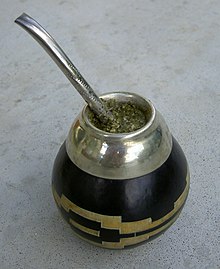Tereré
Tereré or tererê is particularly popular in Paraguay , but also in the northeastern part of Argentina , in the Chaco region of Bolivia , some regions of Chile and in central-western parts of Brazil (states of Mato Grosso do Sul , Mato Grosso , Paraná , Rondônia , Acre ) traditional drink . It is a tea made from mate infused with ice water.
consumption
Especially in hot periods and in the subtropical areas of Argentina, Bolivia, Brazil and Paraguay, Tereré is preferred to hot mate due to the high temperatures during the day. Often the Tereré drinking is celebrated in a group with friends, in which the drinking vessel is passed around. The youngest person pours out and everyone drinks the Guampa one after the other . In Paraguay, Tereré has a special cultural meaning.
preparation
As with mate tea, a special vessel ( called guampa in Paraguay ) is filled about halfway with the yerba , the yerba is slightly moistened and pressed down, and then ice water is poured over it. Usually crushed herbs, the so-called yuyos or remedios refrescantes such as peppermint, are added to this. It is drunk with the bombilla , a metal drinking tube that has a kind of sieve at the bottom so that you don't drink any pieces of leaf. In contrast to the calebasse - made from pumpkin - in which conventional mate is prepared, the guampa is mostly made of cattle horn with decorations of silver or other metals, or turned from wood. The bombilla is also often made of real silver.
In Argentina, tereré is sometimes drunk with the juice of citrus fruits and occasionally even with carbonated drinks.
origin
It is not certain when the tradition of drinking tereré began, but a story is told in Paraguay that during the Chaco War soldiers began to drink mate cold to avoid lighting a fire that would betray their position. This is doubted, however, as the indigenous people ( Guaraní ) already had cold infusions . It can therefore be assumed that those soldiers may have rediscovered the drink . However, the Guaraní Tereré did not drink in its current form. The custom of drinking tereré arose only after the arrival of the Europeans.
The Paraguayans use the guaraní term to designate tereré rupa (literally “the tereré bed” or “the tereré rest”), a traditional second breakfast that is consumed in the morning before the first tereré, with it as the cold drink doesn't hit the stomach so bad.
Individual evidence
- ^ Evaristo Eduardo de Miranda: Agricultura no Brasil do Século XXI . 1st edition. Metalivros, São Paulo 2013, ISBN 978-85-85371-99-9 , pp. 268 .

